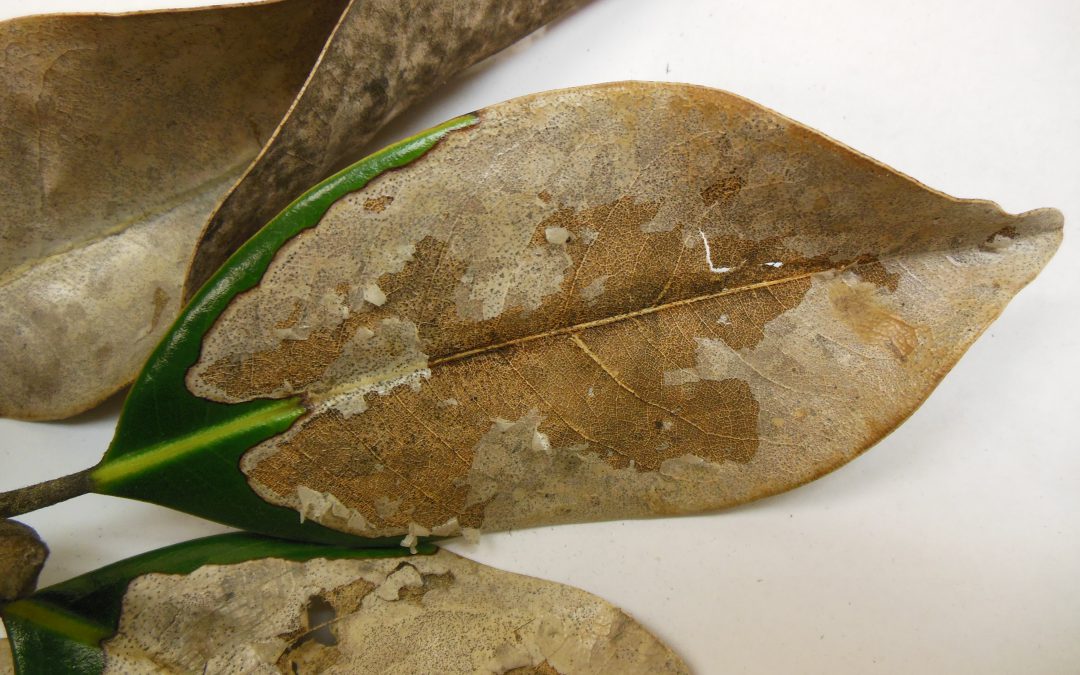
by Mary Salinas | Jun 21, 2013
We love our native magnolias in part because they are tough, easy to care for trees. The mainstay of southern gardens, they grace us with attractive thick, waxy leaves year round and sublimely fragrant and graceful blooms.
However, this past spring brought conditions that encouraged a fungal leaf disease known as anthracnose, most noticeably on the southern magnolia, Magnolia grandiflora. Affected leaves develop large irregular dead patches with a clearly defined border. The dead patches are a brownish gray and will flake and eventually deteriorate and fall away from the rest of the leaf. Fortunately it is rare for the disease to affect all branches of the tree and infection is somewhat spotty as you can in the photograph below.
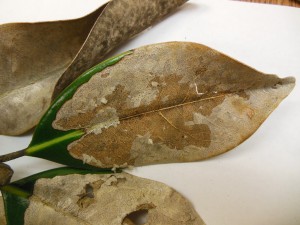
Credit: Mary Derrick, UF/IFAS Extension
Conditions that favor the development of anthracnose in magnolia are the cooler, moister conditions that the panhandle experienced this early spring. Spores overwinter on affected branches and in leaf litter and travel to their new hosts through rain, wind and splashing water.
View this article to learn more about the Southern Magnolia
[important]The good news is that this disease is rarely a serious threat to the long term health of the magnolia. [/important]
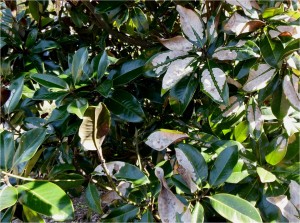
Credit: Mary Derrick, UF/IFAS Extension
But in order to avoid another infection next spring, remove and dispose of as many affected leaves as possible from the tree and certainly those that have fallen. Avoid irrigation that wets the leaves because the consistent presence of moisture on the leaf is a perfect incubator for anthracnose. Ensure that there is sufficient air flow around the trees. Fungicidal treatment is generally not warranted.
by Larry Williams | Jun 17, 2013
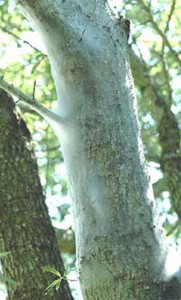
Tree cattle webbing. Photograph by Douglas L. Caldwell, University of Florida
Many people are noticing small insects on trunks and branches of their trees. When disturbed, these insects move in a group and are commonly called tree cattle because of this herding habit. They are ¼ inch brownish-black insects with white markings. Some people assume that these insects will injure their trees but they are harmless. They could be considered beneficial.
Before you spray your tree to control these insects, click on the following link and read the entire article.
Tree cattle are harmless
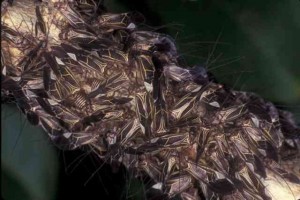
Tree cattle. Photograph by Jim Castner, University of Florida
by | Jun 4, 2013
Proper watering can make the difference between life and death to newly planted lawns, trees, shrubs, bedding plants, vegetable transplants and ground covers during the summer.
Because their roots have not had time to grow out into the surrounding soil, these plants do not yet have well-established root systems. With their root systems still limited to a relatively small area of soil, they are especially vulnerable to drought stress.
Trees
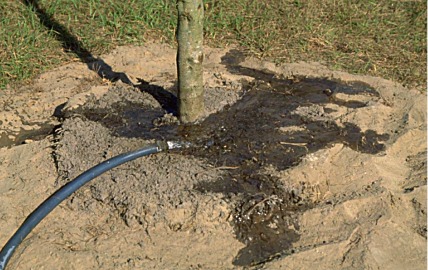 The first summer after planting is the most critical time for newly planted trees, and proper watering plays a major role in whether or not they survive – or how well they survive. Here are some effective watering techniques for trees.
The first summer after planting is the most critical time for newly planted trees, and proper watering plays a major role in whether or not they survive – or how well they survive. Here are some effective watering techniques for trees.
One good method is to turn a hose on trickle, lay the end on top of the ground within 6 inches of the trunk of the tree and let the water trickle for about 20 minutes to 30 minutes. Or build a 4-inch high levee out of soil around the edge of the area dug up to plant the tree. Fill this area with water and let it slowly seep into the root zone.
I’ve found one of the best methods is to use a heated metal skewer or ice pick to pierce five to 10 holes through the bottom of a 5-gallon paint bucket or similar container. Make all the holes on one side. Place the bucket next to the tree trunk with the holes closest to the trunk. Fill up the container, and the water will slowly seep through the holes, providing excellent irrigation. If you want, you can spray paint the outside of the bucket dark green to make it less noticeable.
Use any of these techniques during hot weather whenever seven to 10 days pass without substantial rainfall. Continue to water twice a week until a good rain occurs. Drought-stressed trees may experience wilting, leaf drop, yellow or brown leaves, scorched leaf edges or even death.
Shrubs
Newly planted shrubs will need to be monitored more carefully and watered more frequently than established shrubs. Water with soaker hoses or sprinklers left on long enough for the water to penetrate at least 4 to 6 inches into the soil.
Keep in mind that all of a newly planted shrub’s roots are in a small area – about the size of the pot the shrub was growing in before planting. This is especially true for shrubs planted after March, since they have had little time to grow roots into the surrounding soil. A shrub can use up all the water in its root ball and become drought stressed even though the soil in the bed outside of the root ball is moist. So when checking the soil moisture in the bed, always be sure to stick your fingers right around the shrubs themselves.
Lawns
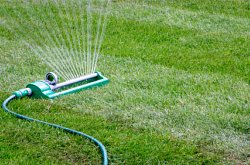 Now is a great time to lay sod to install a new lawn or repair an established one. But keep in mind that newly laid sod needs special attention to watering.
Now is a great time to lay sod to install a new lawn or repair an established one. But keep in mind that newly laid sod needs special attention to watering.
Water newly laid sod for about 15 to 20 minutes every day for the first seven to 10 days. Then water for about 30 minutes every other day for another seven to 10 days. After that, irrigate the lawn thoroughly once or twice a week, as needed, to encourage the roots to grow deep into the soil.
Do not water every day for more than 10 days or you may encourage fungus diseases. And, of course, there is no need to water if adequate rainfall occurs.
Seeds
Water seeded areas (vegetable seeds, flower seeds or lawn seeds) lightly by hand or with sprinklers every day until the seeds germinate and start to grow. It is critical for the soil to stay moist during germination.
Once the seeds come up, water more thoroughly less often to encourage the roots to grow deep into the soil. As the seedlings become established, water normally as needed.
Containers
 Watering plants in containers outside is a constant job during the summer. It is typical to water every day, even twice a day, when weather is hot and dry. Keep this in mind when considering how many outside container plants you can maintain.
Watering plants in containers outside is a constant job during the summer. It is typical to water every day, even twice a day, when weather is hot and dry. Keep this in mind when considering how many outside container plants you can maintain.
How often you have to water container plants is influenced by temperature, pot size, the type of potting mix, the drought tolerance of a plant, whether a plant is in sun or shade and how pot bound a plant is. Plants need to be watered more frequently when it is hot, if the containers are small, if a light potting mix is used, when plants are in a sunny location and when plants are pot-bound. In addition, clay pots tend to dry out faster than plastic or glazed ceramic pots.
To reduce the amount of watering you have to do, use larger rather than smaller pots, choose a potting mix that retains more water (it must still be fast draining, however), repot pot-bound plants into larger containers, use plastic pots and, if practical, move the plants into somewhat shadier conditions.
Potting mixes will retain more water with the addition of hydrophilic polymers. These gelatin-like particles hold large amounts of water without creating a waterlogged soil condition. Look for these polymer products or potting mixes that contain them where garden supplies are sold.
by Sheila Dunning | Apr 12, 2013
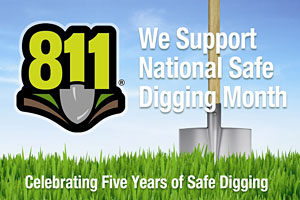 This month, recognized by the Senate and Florida’s governor, reminds diggers why calling 811 before all outdoor digging projects is important to your safety. Before installing a mailbox, fence, deck, garden or tree make sure to call Sunshine 811 to have underground lines marked. 811 is the free national number designated by the Federal Communications Commission. It notifies utility companies, who in turn send their professional locators to identify and mark the appropriate location of underground line with paint and flags in colors that identify the utility type. The following colors represent the seven various utilities: red – electric, orange – communications (telephone, cable tv), blue – potable water, green – sewer, yellow – gas, purple – reclaimed water, and white – site of intended excavation. To learn more about color designation and their corresponding utility go to: http://www.call811.com/faqs/default.aspx. Locate marks are good for 30 calendar days. Any work beyond that requires another call to 811. If the marks are destroyed before your project is done, stop digging and call 811.
This month, recognized by the Senate and Florida’s governor, reminds diggers why calling 811 before all outdoor digging projects is important to your safety. Before installing a mailbox, fence, deck, garden or tree make sure to call Sunshine 811 to have underground lines marked. 811 is the free national number designated by the Federal Communications Commission. It notifies utility companies, who in turn send their professional locators to identify and mark the appropriate location of underground line with paint and flags in colors that identify the utility type. The following colors represent the seven various utilities: red – electric, orange – communications (telephone, cable tv), blue – potable water, green – sewer, yellow – gas, purple – reclaimed water, and white – site of intended excavation. To learn more about color designation and their corresponding utility go to: http://www.call811.com/faqs/default.aspx. Locate marks are good for 30 calendar days. Any work beyond that requires another call to 811. If the marks are destroyed before your project is done, stop digging and call 811.
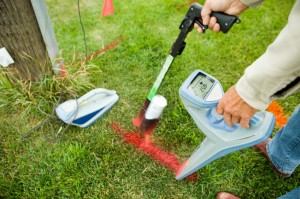
Hitting an underground utility line while digging can cause injuries, utility service outages to an entire neighborhood and damage to the environment. The depth of utility lines varies, and there may be multiple utility lines in one common area. Even if you think you know where an underground line is, time tends to change things. Erosion or tree roots can shift those utility lines. Failure to call before digging results in one unintentional utility hit every eight minutes nationwide. You could also be financially affected with costly fines and high repair costs.
The Common Ground Alliance (CGA) Damage Information Reporting Tool (DIRT) provides industry stakeholders with a way to anonymously submit data into a comprehensive database for analysis of the factors that lead to events. An event is defined by the CGA DIRT User’s Guide as “the occurrence of downtime, damages, and near misses.” The number of events submitted to DIRT for 2011 totaled 207,779. However, according to CGA DIRT “when a call is made to the one call canter (811) prior to excavation, 99% of the time there will be no damage”.
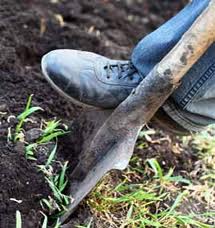
Calling 811 in Florida is the law. At least two full business days before digging, do-it yourselfers and professional excavators must contact 811 by phone to start the process of getting underground utility lines marked. This is a free service. Be sure that all utilities have been marked before grabbing the shovel. If you don’t see locate marks, don’t assume there are no underground utility lines. Verify with the Sunshine 811 Positive Response system. Follow up on your one call ticket by contacting 811 again on the third day. Sunshine State One Call is a not for profit corporation which began with the 1993 adoption of the “Underground Facility Damage Prevention and Safety Act,” Chapter 556, Florida Statutes. Online you can visit: www.online811.com, or call (800) 852-8057. If you provide a valid e-mail when requesting your locate ticket, positive response updates will automatically be sent to you when all utilities have responded. For more information on Florida’s law, visit www.Sunshine811.com.
by Matthew Orwat | Feb 15, 2013
According to the National Weather Service a mild freeze is predicted for Northwest Florida this weekend, specifically Saturday night to Sunday morning. Washington County Horticulture extension agent Matthew Orwat says,” While mature, dormant Satsuma trees are cold hardy down to 14° – 18 °F, young trees need protection if temperatures dip into the upper 20s.”
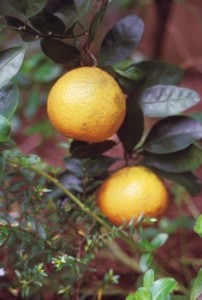
Photo Credits David Marshall
Here are a few techniques to protect young citrus trees from late-season freezes:
- Wrap the trunk with commercial tree wrap or mound soil around the base of the tree up to 2 feet. This will protect the graft of the young tree. Thus, if the branches freeze the graft union will be protected.
- Cover the tree with a cloth sheet or blanket. For additional protection, large bulb Christmas lights may be placed around the branches of the tree. This will increase the temperature under the cover by several degrees. Be sure to use outdoor lights and outdoor extension cords to avoid the potential of fire.
- Water your Satsuma trees. Well watered trees have increased cold hardiness.
- Frames may be installed around young trees to hold the cover. This option keeps the blanket or sheet from weighing down the branches.
- For homeowners with lemon, lime or other less cold hardy citrus, micro-irrigation is an option. This practice will protect citrus trees up to 5 feet, but must be running throughout the entire freeze event. For additional information click here.
- Always remember to remove cold protection once the temperature rises so that the trees do not overheat
- Do not cover trees with plastic tarps, these will not protect the tree and can “cook” the tree once temperatures rise.
Please see the following publications by retired UF / IFAS Extension agents Theresa Friday and David Marshall for additional information regarding freeze protection of citrus.
by Carrie Stevenson | Jan 11, 2013
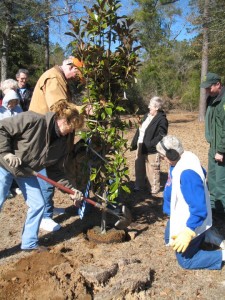
Master Gardeners demonstrate correct tree planting techniques.
Arbor Day (which literally means, “Tree Day”) was founded in 1872 by J. Sterling Morton, a naturalist and journalist in Nebraska. By 1882, it was celebrated by thousands of schoolchildren nationwide, who planted trees and took care of them with their classmates. Today, millions of communities and schools celebrate Arbor Day all over the world. Trees provide endless benefits, including shade, recreation, food and building products, wildlife habitat, oxygen production, and carbon dioxide uptake.
Arbor Day is typically celebrated in the United States on the last Friday of April, but as ideal tree-planting conditions differ by climate, each state has its own specific Arbor Day, as well. Winter is the ideal time to plant trees in Florida, because it allows roots to develop without expending energy on growing new leaves and shoots. Our state celebration this year is January 18th. Many local communities in Florida hold special events around this time, including:
Escambia County:
Extension and Water Quality divisions are partnering with the Florida Forest Service to give away 4,000 seedling trees, including Crabapple, Mayhaw, Cherrybark Oak, Wax Myrtle, Bald Cypress, and River Birch. There are two events: January 14 from 9:30-11:00 am at the Walnut Hill Ruritan (7850 Highway 97), and January 18 at Pensacola State College Warrington (198 Patton Drive) from 11:00 am- 2 pm. The Jan. 18 event will include a tree planting demo at Pensacola State College and dedication of the Southwest Greenway Trail Opening Celebration. For more information contact Beth at bbolles@ufl.edu
Okaloosa County:
Okaloosa Extension will host a tree giveaway on Jaunary 18 from 9 am – 12 noon, in conjunction with the county and state forestry service. Trees available include Mayhaw, Red Maple, Cherrybark Oak, and Yellow Poplar. The schedule includes a dedication and installation of a Winged Elm, demonstration on correct tree planting and a guided tour of the new Extension building. Okaloosa County UF Extension Office, 3098 Airport Road, Crestview, Florida. For more information, contact Sheila at sdunning@ufl.edu
Walton County:
An Arbor Day celebration will be held on Friday, January 25 in the DeFuniak Springs Lakeyard. Former first lady, Rosalyn Carter will be present at tree planting ceremony around lunch time. For more information, contact Mike at mjgo@ufl.edu
Leon County:
Arborist Stan Rosenthal will host an Arbor Day tree planting on Saturday, January 26 at Lafayette Park in Tallahassee. The event starts at 9:00 am. For more details, contact Stan at stanr@ifas.ufl.edu
Click here to find more information about ways to celebrate Arbor Day.













